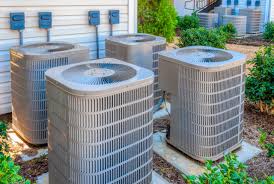
#1 Air Filter Changeout
A filter is there to capture dust in the air, filter it out and send you back cleaner air. As that filter gets old and collects dirt and dust, it starts to block the air flow causing your system to work harder which can shorten the life of and also reduces the quality of the air. Filters have different lifespans depending on which one you get. As an extra tip make sure when installing the filter the arrow points towards the direction of the airflow and also write on the filter the date you changed it in case you ever want to go back and check.

#2 Coil Cleaning
Your ac system has 2 coils with one of them being outside and subject to the elements. This coil needs to be cleaned annually so that it works properly. The easiest way to wash it is with a water hose and a adjustable tip. Key point is not to bend the delicate coils while washing them so don’t have it full blast or to close. If you notice the fins start to bend stop what you’re doing and reduce the water pressure. Bending the fins can completely block the air flow which could lead to damage to your equipment. The other coil is inside the house usually in the attic or closet. This coil may or may not have access as it is enclosed inside a metal box. The air inside the house passes over this coil and if you keep a clean air filter that should keep this coil clean. A sign that this coil could be dirty would be a clogged drain line. This coil condensates and the water runs down the coil collecting any dirt that has gotten caught in the coil carrying it into the drain line. Over time this drain line can get clogged. I would not recommend opening the box with the coil if it does not already have easy access to it. Re-sealing that box after opening is very important as it is the supply of air into your house. Any leaks can allow air out or anything to slip in the cracks.

#3 Drain Line Cleaning
The drain line is there so that water does not build up in the coil inside the house. The drain line will run from the unit to the plumbing in the house. Sometimes it even runs to a sink in the restroom or could run directly to the outside along with the secondary drain line which is there if the primary drain line gets clogged up. One way to clean it is with air from a vacuum, compressed air, or water. You need pressure to push anything in the pipe out to clear it. There are also some tablets that you can put in the drain line that slowly dissolves over time and eats away at any algae that may be building up in the line.

#4 Capacitor and Contactor Test
A common component that goes out on a system is the capacitor. It can be found on the outside unit. It does not do well in prolonged high heat. Hot summer days can cause this components to fail. One way to avoid it failing is to test it annually to make sure it is still in good shape. If you find that it is having issues the best thing to do is to replace the part. To test this components you need a multimeter that can test for microfarads and ohms. If you are not a professional who knows how to use a meter or the safety of working around electricity I would not suggest you start now. A capacitor can be charged and if you were to touch the prongs you could get a good shock! Also anytime you work on electrical components you want the power off and verify that it is off. This test should be done by a professional. The only way to test a capacitor is with the wires removed from it. It is easy to make a mistake when putting the wires back, the wires go exactly back to the correct terminals they came out from. Putting them back in the wrong location can damage your equipment. The capacitor will tell you what the charge should be. Using the meter you can test for what the actual charge is.

#5 Compressor Test
The heart of your system is the compressor. It is the pump that moves the juice back and forth creating a loop of adding cooling and removing heat. While it is running you can get an amp draw with a multimeter. Putting the amp clamp around one of the compressor wires will give you the amp draw of the compressor while it’s running. The unit will have a tag on it that states what the amp draw should be from the compressor. Compare that to the actual amp draw you got from the meter and bada-bing you have your results. As long as the amp draw is under the recommended value you are doing good. If the compressor is over amping it may be signaling a bigger problem on the horizon. Make sure this test is done by a professional, working around electricity is very dangerous and these machines have their own challenges when working with them.
The key takeaway is to keep a maintenance schedule for your equipment so that it will last a long time.
Like the old saying goes :
“You take care of it, and it will take care of you”